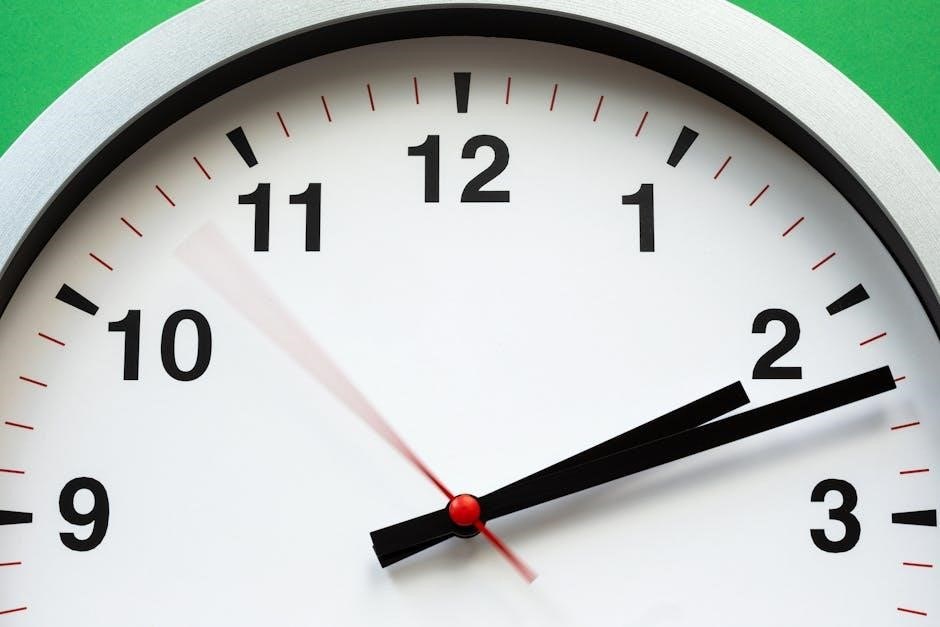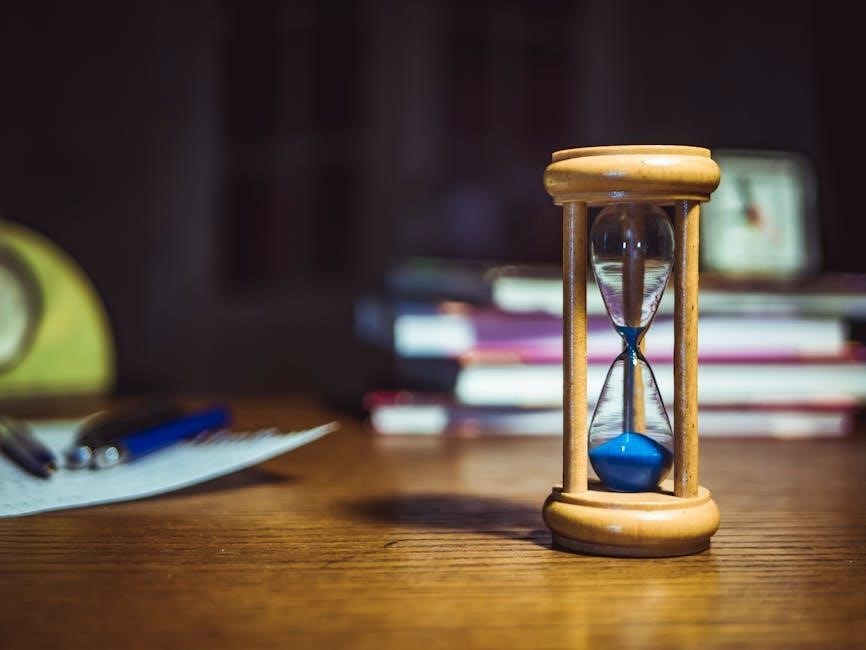Understanding Taylor Timers
Taylor timers are known for their accuracy and ease of use. These timers, often digital, are essential kitchen tools. Understanding their features is key to effective use. Manuals provide valuable insights into specific models. Taylor timers offer versatility for various timing needs.
Overview of Taylor Timer Models
Taylor offers a diverse range of timers, each designed for specific needs. The Taylor 5806, a digital timer, is popular for its simplicity. Multi-purpose digital timers provide both count-up and count-down functions. Dual event timers, like some models, allow programming two events simultaneously. Kitchen clip timers with magnets offer convenient mounting options. Some models, such as the Taylor 5820, have minute and second buttons for easy setup.
The Taylor 5880 is designed to be user-friendly, featuring clear instructions. The Taylor 5863 (Splash n Drop Timer) showcases superior design. Some timers include clock and calendar functions. Taylor timers are versatile, catering to various cooking and baking requirements. They are examples of superior design and craftsmanship. Choosing the right model depends on individual preferences and needs. Instruction manuals provide essential details for each timer’s functionality. Understanding the features ensures optimal use and satisfaction. Taylor timers offer a reliable solution for precise timing in the kitchen, solidifying their place as essential cooking aids.

Importance of Instruction Manuals
Instruction manuals are crucial for understanding Taylor timer functions. These manuals provide detailed guidance on setup and operation. They explain features like countdown and dual event timing. Manuals offer troubleshooting tips for common issues, such as alarm failures. The Taylor 5806 manual, for example, details setting minutes. The Taylor 5873 manual addresses alarm troubleshooting steps. Manuals often include specifications and safety precautions.
Reading the manual ensures proper timer usage and longevity. They are essential for maximizing timer functionality. Instruction manuals clarify clock settings and timer programming. They guide users through specific model features. Ignoring the manual may lead to incorrect settings or damage. Taylor timers come with user manuals for ease of use. These manuals act as a go-to guide for seamless navigation. Keeping the instructions handy allows for future reference. Manuals clarify setting the clock, programming events and selecting modes. Instruction manuals are essential for all users.

Setting Up Your Taylor Timer
Setting up your Taylor timer involves initial steps. Ensure proper battery installation for digital timers. Familiarize yourself with clock settings. The bottom switch often controls clock settings. Use ‘H’ and ‘M’ buttons to adjust time accurately.
Initial Setup and Battery Installation
The initial setup of your Taylor timer is crucial for optimal performance. Begin by carefully unpacking the timer and inspecting all components. Refer to the instruction manual for a detailed parts list and diagram to ensure nothing is missing.
Next, focus on battery installation. Locate the battery compartment, typically on the back or bottom of the timer. Use a small screwdriver if necessary to open the compartment. Note the correct battery type required, as specified in the manual (usually AAA or button cell batteries).
Insert the batteries, paying close attention to the polarity (+ and -) markings inside the compartment. Incorrect battery placement can damage the timer or prevent it from functioning. Once the batteries are correctly installed, securely close the battery compartment.
If the timer doesn’t power on immediately, double-check the battery polarity and ensure the batteries are fresh. Some models might have a reset button that needs to be pressed after battery installation. Consult the manual for troubleshooting steps if needed. Proper battery installation ensures your Taylor timer is ready for accurate timekeeping and timing tasks.
Clock Setting Instructions
Setting the clock on your Taylor timer is a straightforward process. First, locate the “Clock Set” button or switch. Some models may require you to slide a switch on the bottom of the timer to the “CLOCK SET” position. Once in clock setting mode, the display will typically flash, indicating that you can now adjust the time.
To set the hour, press the “H” button. The hour will advance with each press. Some timers offer a choice between 12-hour (AM/PM) and 24-hour modes. Refer to the manual for instructions on how to switch between these modes. Once the correct hour is displayed, proceed to set the minutes.
Press the “M” button to adjust the minutes. Similar to setting the hour, the minutes will advance with each press. After setting the minutes, some timers may require you to press a “Confirm” or “Start/Stop” button to finalize the time setting.
If you make a mistake, consult the manual for instructions on how to reset the clock or adjust the time. Once the clock is set, ensure the timer is switched back to the normal operating mode. A correctly set clock ensures accurate timing for your culinary and other activities.
Switch on the bottom of the timer to CLOCK SET
Many Taylor timers feature a small switch located on the bottom of the unit. This switch is crucial for transitioning between the timer’s normal operating mode and the clock setting mode. Before attempting to set the time, it’s essential to locate this switch and slide it to the position labeled “CLOCK SET.”
This action disengages the timer function, allowing you to adjust the clock without inadvertently starting a countdown or interfering with any programmed timing events. The “CLOCK SET” position prepares the timer’s internal mechanism for accepting time input.
Once the switch is in the correct position, the display will likely indicate that it’s ready for time adjustment, often by flashing the digits. This visual cue confirms that you can now proceed with setting the hour and minutes;
After completing the clock setting process, remember to slide the switch back to its original position, typically labeled “RUN” or “TIMER.” This re-engages the timer function, allowing you to use it for its intended purpose of counting down or counting up. Failing to switch back may prevent the timer from functioning correctly. Consult your user manual for specific details.
Press H to set the hour ( 1-11 AM/PM or 24 hour mode).
After sliding the switch to the “CLOCK SET” position, the next step is to set the hour. Look for a button labeled “H” on the timer’s interface. This button is specifically designated for adjusting the hour. Pressing the “H” button will increment the hour displayed on the screen.
Most Taylor timers offer a choice between a 12-hour (1-11 AM/PM) mode and a 24-hour mode. The method for switching between these modes varies depending on the model. Some timers may have a dedicated button for this purpose, while others may require holding down the “H” button for a few seconds. Consult your timer’s instruction manual for specific instructions.
When setting the hour in 12-hour mode, pay attention to the AM/PM indicator on the display. Ensure that you are setting the correct time of day. In 24-hour mode, the hours are represented from 00 to 23.
Continue pressing the “H” button until the desired hour is displayed. Once you have set the correct hour, proceed to set the minutes using the “M” button. Remember to double-check the time before confirming the setting.
Press M to set minutes the to confirm time setting.
Following the hour setting, the next crucial step involves setting the minutes on your Taylor timer. Locate the button labeled “M,” typically positioned near the “H” button. This “M” button is specifically designed for adjusting the minutes. Each press of the “M” button will increment the minutes displayed on the timer’s screen.
Continue pressing the “M” button until the desired minute value is reached. If you accidentally overshoot the correct minute, you may need to cycle through all the minutes again, depending on the timer model. Some models may have an additional button to decrease the minutes, offering more precise control.
After setting the minutes, carefully review the displayed time, ensuring both the hour and minutes are accurate. This step is crucial for the timer to function correctly. Once you are satisfied with the time, proceed to confirm the time setting.
The confirmation method varies depending on the Taylor timer model. Some timers automatically confirm the time after a few seconds of inactivity. Others require pressing a specific button, often the “START/STOP” or a dedicated “SET” button. Refer to your timer’s instruction manual for precise instructions on confirming the time setting. Once confirmed, your Taylor timer is set and ready for use.

Using Timer Functions
Taylor timers offer countdown and dual event timing. Setting minutes and seconds is crucial. Activating and deactivating the alarm is simple. Dual event operation allows multitasking. These features enhance cooking precision. Refer to the manual for detailed instructions.
Countdown Timer Instructions
To utilize the countdown timer function on your Taylor timer, begin by pressing the designated button, often labeled “TIMER” or “START/STOP”, to enter timer mode. Next, set the desired time using the minute (“M”) and second (“S”) buttons; hold these down to advance quickly. The timer can be programmed for up to 99 minutes and 59 seconds, suitable for various applications.
Once the time is set, press the “START/STOP” button to initiate the countdown. The display will show the remaining time decreasing. When the timer reaches zero, an alarm will sound.
To stop the alarm, press the “START/STOP” button again. If the alarm doesn’t sound, consult the manual. For dual timers, follow specific instructions for Timer 1 or Timer 2. Remember, multitasking is easier with this feature. Always consult the product manual for model-specific details and troubleshooting tips. This ensures accurate and efficient use. This versatile function makes timing tasks simple.

Setting Minutes and Seconds on Digital Timers
Setting the minutes and seconds on your Taylor digital timer involves a straightforward process. First, locate the “M” button for minutes and the “S” button for seconds. Press the “M” button to increase the minutes to the desired value. If you need to adjust the seconds, use the “S” button in a similar fashion.
For faster adjustments, hold down either button to advance the digits quickly. Ensure that you set the correct values before starting the timer. After setting, confirm the time displayed is accurate. Some models may have a “CLEAR” button to reset if needed.
Refer to your timer’s manual for specific instructions, as button layouts may vary between models. The Taylor 5806, for instance, requires pressing the “M” button to adjust minutes. Remember to double-check your settings before initiating the countdown to ensure precise timing for your cooking or other tasks. Proper setting ensures optimal use.
Activating and Deactivating the Alarm
Activating and deactivating the alarm on a Taylor timer is a simple process. Typically, pressing the START/STOP button initiates the countdown. Once the timer reaches zero, the alarm will sound. To deactivate the alarm, press the START/STOP button again.
Some models may require holding the button for a few seconds. If the alarm doesn’t sound, check the volume setting or replace the battery. Ensure the timer is not in silent mode if applicable. For dual event timers, verify which timer’s alarm is sounding before deactivating.
Refer to your specific Taylor timer model’s manual for detailed instructions. If issues persist, consult the troubleshooting section of the manual. If the alarm fails to deactivate, try resetting the timer. Proper alarm function is crucial for effective time management. Understanding the alarm settings enhances user experience. Always test the alarm after setting the timer to ensure proper activation.
Dual Event Timer Operation
Taylor dual event timers are designed for multitasking in the kitchen; These timers allow programming two separate events simultaneously. To operate, set Timer 1 and Timer 2 independently using the respective buttons. Follow the timer setting instructions for each.
To view the countdown of Timer 2 while Timer 1 is running, press the designated button, often labeled “T2” or similar. The timer continues to operate in the background. Pressing the button again returns the display to Timer 2’s countdown. Some models have a “T1/T2” button to view both timers sequentially.
A flashing indicator, such as “TIMER 1” or “TIMER 2,” may indicate which timer is currently displayed. When both timers are active, manage each independently. Upon completion of each timer, the alarm sounds separately. Deactivate the alarm for each timer individually. This dual functionality enhances meal planning and simplifies complex cooking tasks.



